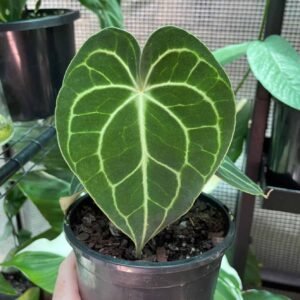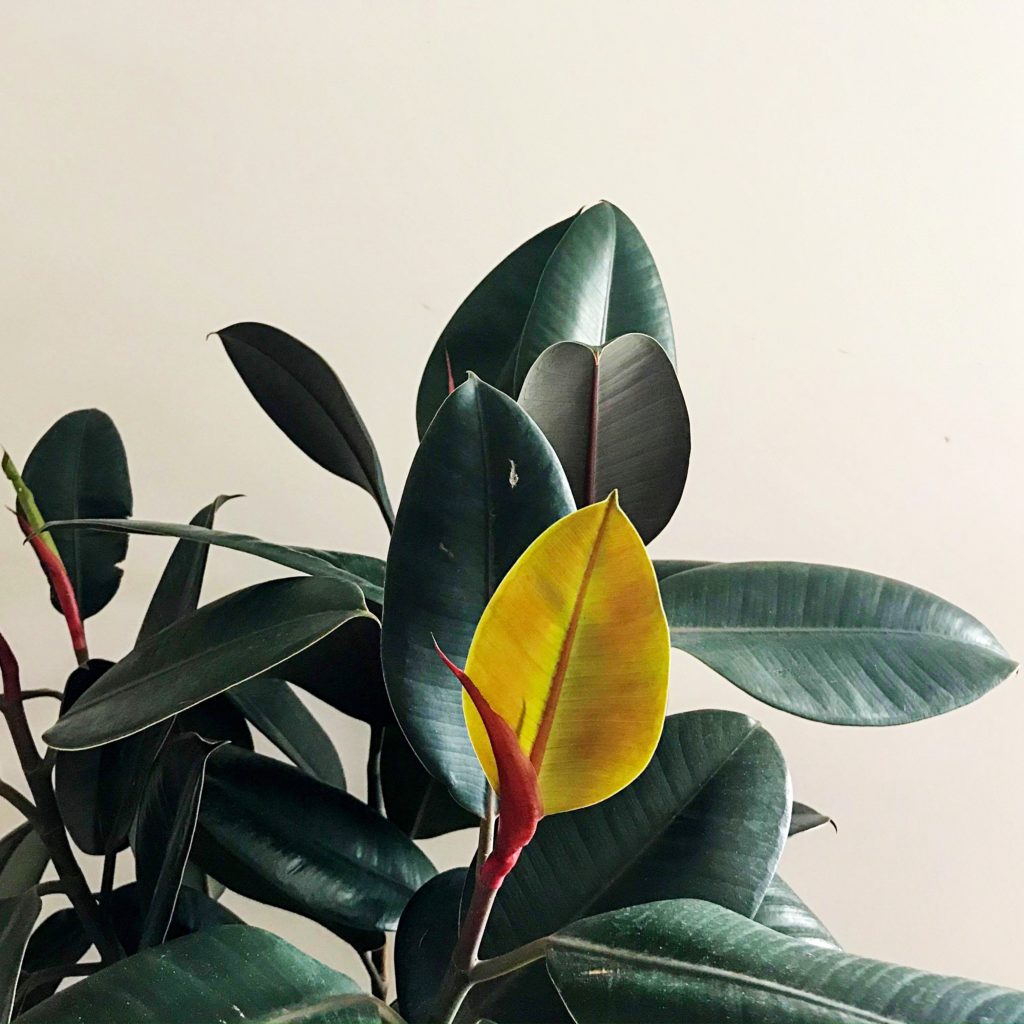Looking for a new, unique addition to your urban jungle? Look no further than the Anthurium Clarinervium! This beautiful and exotic plant, also known as the velvet cardboard anthurium, is native to Mexico and is known for its stunning heart-shaped leaves and velvety texture. We’ll explore everything you need to know about caring for Anthurium Clarinervium.
Despite its exotic appearance, Anthurium Clarinervium are relatively easy to care for and grow indoors. In this article, we will discuss everything you need to know about keeping this stunning plant happy and healthy from light requirements to watering and soil, along with the diseases and pests to look out for.
Anthurium Clarinervium a.k.a Velvet Cardboard Anthurium

Anthurium Clarinervium Quick Overview
| Full Size | Upwards of 2 foot |
| Light | Bright indirect light |
| Temperature | 65ºF-80ºF (18ºC-27ºC) |
| Humidity | Above 60% |
| Cost | $$ |
| Care Level | Easy care |
| Toxicity | Toxic |
Size
The mature size of a Anthurium Clarinervium can be up to 15-25 inches high with a width of around 12-39 inches and leaves that reach around 7-12 inches in size. This plant typically has a slow to moderate growth rate and stays quite compact.
When kept indoors, Anthurium Clarinervium can reach around 24-30 inches in height and width, with leaves reaching upwards of 6 inches in size. Dead, diseased or yellowing leaves and leggy stems can be pruned off to help encourage new and healthy growth. This will also help to improve the plants appearance.
Light Requirements
Anthurium Clarinervium grow best in medium to bright indirect light. This plant doesn’t tolerate low light conditions or direct sunlight. Direct sunlight can burn the foliage and cause the leaves to become pale in colour, start yellowing and wilt from heat stress.
A sign that your Anthurium Clarinervium isn’t receiving enough light is foliage losing its vibrant colour, slow growth and stems becoming leggy. An area that receives bright filtered light like an east facing window is the perfect spot to house your Anthurium.
If your plant is kept in a spot that receives direct sunlight, a blind or curtain can be added to the window to help defuse the harsh sunlight and avoid burning the plants foliage. Grow lights can be used as an alternative option if you can’t find that perfect spot in your home.
Just like direct sunlight, grow lights can burn the foliage if the plant is sitting too close to the lights. A safe distance of at least 60cm should be kept between the plants and lights to avoid any issues.
Temperature
Anthurium Clarinervium love warmer temperatures and will thrive when kept between 65ºF-80ºF (18ºC-27ºC). This plant can tolerate temperatures up to 85ºF (29ºC) however, if it reaches above 90ºF (32ºC), foliage may become faded and dry.
It’s important to try and avoid placing your plant near vents and drafts that can cause sudden temperature fluctuations. Anthurium Clarinervium doesn’t tolerate cold conditions and shouldn’t be kept in temperatures that reach below 55ºF (12ºC). Prolonged exposure to cold temperatures can cause the foliage to start yellowing and plant to stop growing.
Humidity
Anthurium Clarinervium can be kept in a humidity environment that’s above 60%. However, this plant loves humidity and will thrive when kept in an 80% humidity environment. Keeping your plant in a high humidity environment will help with faster growth and keeping foliage vibrant in colour. Brown leaf tips can be a sign that the air is too dry.
Providing an adequate amount of humidity for your indoor plants will help to encourage bigger and healthier growth. If the air in your home is too dry, there are a few things you can try that will help bring up the humidity.
- Misting your plants: Using a spray bottle to spray a fine mist over your plants can help increase the humidity.
- Pebble tray: The water that evaporates from the pebbles/rocks adds additional moisture to the air which helps increase the humidity.
- Group plants together: Grouping plants together can help increase their humidity.
- Humidifier: Humidifiers release water vapour into the air to increase the moisture in the air.
- Greenhouse: Greenhouses can be easier to regulate humidity and temperatures.
Watering Requirements
Your Anthurium Clarinervium will require watering at least once a week. However, this will depend on the climate, season and type of soil you’re using. During the cooler months, watering won’t be required as often since the soil won’t dry out as fast.
Before watering your plant, you should check the top 1-2 inches of soil with your finger. If the soil is dry, you should give your plant some water. If the soil still feels moist, wait until it dries out a bit more to avoid over-watering.
Yellowing leaves can be a sign of an over-watered Anthurium Clarinervium. Brown edges on the leaves, curling leaves and/or stunted growth can be a sign of under-watering.
When it comes to caring for your indoor plants, you need to be cautious of over-watering. Excess water to the soil can cause it to become water-logged, which can cause root rot, pest problems and other fungus issues. Once the roots have rotted, they’re no longer able to provide nutrients or water to the plant. If left untreated, it can cause plant death.
Ensuring your plants are potted in pots with drainage holes and well draining soil can assist in avoiding this common issue. After watering your plants, always ensure the saucers are emptied and plants aren’t sitting in water.
Fertilizing requirements
Anthurium Clarinervium aren’t heavy feeders and only need to be fertilised about every 2 months during the growing period (Spring and Summer). Fertilising can be cut back during the cooler months when growth slows and the plant isn’t actively using up the nutrients in the soil.
Fertilising your houseplants will give them the essential nutrients they need to promote and maintain new and healthy growth. Applying fertiliser when plants aren’t actively growing and using the nutrients in the soil can cause salt build up and root burn.
The best fertiliser to use for Anthurium Clarinervium is a balanced all purpose fertiliser diluted to half strength. It’s best to try and avoid any cheap fertilisers as they are often high in salts which can damage the roots.
A slow release fertiliser can be used instead of a liquid fertiliser if preferred. They are often easier to use and won’t need to be applies as often. Apply a slow release fertiliser every 3 months or as per packet instructions.
Every 3-4 months, it is recommended to flush the soil to prevent any mineral salt build up. To flush the soil, run water through for about 1-2 minutes. This will help clean out excess fertiliser and salts.
When fertilising houseplants, you should be cautious of over-fertilising. Over-fertilisng your Anthurium Clarinervium can burn the foliage and roots. If you think you have given your plant too much fertiliser, you can either change the soil or rinse the fertiliser out with water. The water colour will change when the fertiliser has been rinsed out.
Soil Requirements
Anthurium Clarinervium will grow best in a loose, well draining soil. To create an ideal mix, use a mixture of potting soil, orchid bark, peat moss and perlite. This mixtures helps to create drainage and aeration while still retaining moisture.
Oxygen is important when it comes to potting soil as it allows the plants roots to breathe. The plants roots can start rotting if they don’t have access to enough oxygen. You can also add other materials such as charcoal, mulch, bark chips or sphagnum moss to the soil mix to improve drainage.
You want the soil to hold enough moisture to keep the roots hydrated but not too much that it causes the soil to become soggy and/or waterlogged. If the soil stays too wet, it can cause root rot and fungus issues that can kill your plant. Check out The Best Potting Soil for Houseplants for more information on potting soil.
Diseases & Pests
Some of the most common pests that you may see on your Anthurium Clarinervium are mealybugs, spider mites, scale, thrips and aphids. The most common diseases you may encounter are leaf blight and root rot.
When it comes to caring for indoor plants, the best thing you can do is try and prevent any pest infestations from starting. There are some things you can do that will help prevent any pest infestations and these are:
- Check new plants for pests and/or isolate them for up to a week.
- Check plants for pests at lease once a week.
- Prune off any dying and dead foliage.
- Clean leaves when they start getting dusty or dirty.
- Try keep plants healthy. Healthy plants will handle a pest infestation much easier than those that aren’t as happy and healthy.
- Isolate any pest infested plants.
Following this will help keep pests away as well as catch any cheeky pests early before any infestations can start. Keeping happy and healthy houseplants in the correct living environments can also help keep away any pests.
Toxicity
Anthurium Clarinervium is toxic to pets and humans if ingested. The plant contains calcium oxalate crystals that can cause irritation to the mouth and digestive tract.
Symptoms can include swelling of the oesophagus, GI tract and mouth. Pets may experience vomiting, drooling, pawing at the mouth and lack of appetite. Plant should be kept away from small children and pets.



